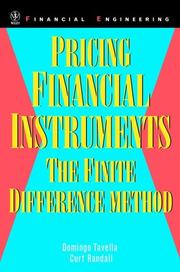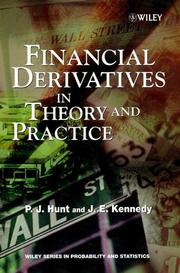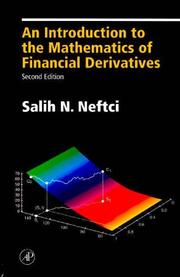| Listing 1 - 10 of 60 | << page >> |
Sort by
|
Book
ISBN: 0905625900 9780905625904 Year: 2000 Publisher: London: International accounting standards committee,
Abstract | Keywords | Export | Availability | Bookmark
 Loading...
Loading...Choose an application
- Reference Manager
- EndNote
- RefWorks (Direct export to RefWorks)

ISBN: 0471197602 9780471197607 Year: 2000 Publisher: New York Wiley
Abstract | Keywords | Export | Availability | Bookmark
 Loading...
Loading...Choose an application
- Reference Manager
- EndNote
- RefWorks (Direct export to RefWorks)
Numerical methods for the solution of financial instrument pricing equations are fast becoming essential for practitioners of modern quantitative finance. Among the most promising of these new computational finance techniques is the finite difference method-yet, to date, no single resource has presented a quality, comprehensive overview of this revolutionary quantitative approach to risk management.Pricing Financial Instruments, researched and written by Domingo Tavella and Curt Randall, two of the chief proponents of the finite difference method, presents a logical framework for applying the method of finite difference to the pricing of financial derivatives. Detailing the algorithmic and numerical procedures that are the foundation of both modern mathematical finance and the creation of financial products-while purposely keeping mathematical complexity to a minimum-this long-awaited book demonstrates how the techniques described can be used to accurately price simple and complex derivative structures.From a summary of stochastic pricing processes and arbitrage pricing arguments, through the analysis of numerical schemes and the implications of discretization-and ending with case studies that are simple yet detailed enough to demonstrate the capabilities of the methodology- Pricing Financial Instruments explores areas that include:Pricing equations and the relationship be-tween European and American derivativesDetailed analyses of different stability analysis approachesContinuous and discrete sampling models for path dependent optionsOne-dimensional and multi-dimensional coordinate transformationsNumerical examples of barrier options, Asian options, forward swaps, and moreWith an emphasis on how numerical solutions work and how the approximations involved affect the accuracy of the solutions, Pricing Financial Instruments takes us through doors opened wide by Black, Scholes, and Merton-and the arbitrage pricing principles they introduced in the early 1970s-to pr
Partial differential equations --- Capital structure --- Options (Finance) --- Financial instruments --- Options (Finances) --- Prices --- Prix --- Prices.
Book
ISBN: 2717841172 Year: 2000 Publisher: Paris : Economica - anthropos,
Abstract | Keywords | Export | Availability | Bookmark
 Loading...
Loading...Choose an application
- Reference Manager
- EndNote
- RefWorks (Direct export to RefWorks)
Risk management --- Investments --- Financial instruments --- Gestion du risque --- Investissements --- Instruments financiers
Periodical
Abstract | Keywords | Export | Availability | Bookmark
 Loading...
Loading...Choose an application
- Reference Manager
- EndNote
- RefWorks (Direct export to RefWorks)
Financial instruments --- Instruments financiers --- Taxation --- Law and legislation --- Impôts --- Droit --- United States.
Periodical
Abstract | Keywords | Export | Availability | Bookmark
 Loading...
Loading...Choose an application
- Reference Manager
- EndNote
- RefWorks (Direct export to RefWorks)
Financial instruments --- Instruments financiers --- Accounting & Tax. --- Taxation --- Law and legislation --- Impôts --- Droit --- Taxation. --- Law and legislation. --- United States.
Periodical
Abstract | Keywords | Export | Availability | Bookmark
 Loading...
Loading...Choose an application
- Reference Manager
- EndNote
- RefWorks (Direct export to RefWorks)
Financial instruments --- Instruments financiers --- Accounting & Tax. --- Taxation --- Law and legislation --- Impôts --- Droit --- Taxation. --- Law and legislation. --- United States.

ISBN: 9041197818 Year: 2000 Volume: 16 Publisher: Hague, Netherlands ; Cambridge, MA : Kluwer Law International,
Abstract | Keywords | Export | Availability | Bookmark
 Loading...
Loading...Choose an application
- Reference Manager
- EndNote
- RefWorks (Direct export to RefWorks)
Capital market --- Marché financier --- Law and legislation --- Droit --- Derivative securities --- Financial instruments. --- Law and legislation. --- AA / International- internationaal --- 347.734 --- 333.605 --- U70 - Produits dérivés - Afgeleide produkten --- -346.0922 --- Jb3.e --- Derivative financial instruments --- Derivative financial products --- Derivative instruments --- Derivatives (Finance) --- Financial derivatives --- Securities --- Structured notes (Securities) --- Bank- en spaarinstellingen (recht). --- Nieuwe financiële instrumenten. --- Marché financier --- Financial instruments --- 346.0922 --- Capital instruments --- Legal instruments --- Negotiable instruments --- Nieuwe financiële instrumenten --- Bank- en spaarinstellingen (recht)
Book
ISBN: 1462330681 1452779449 1282106724 1451904665 9786613800077 Year: 2000 Publisher: Washington, D.C. : International Monetary Fund,
Abstract | Keywords | Export | Availability | Bookmark
 Loading...
Loading...Choose an application
- Reference Manager
- EndNote
- RefWorks (Direct export to RefWorks)
This paper analyzes the stochastic inventory control problem when the demand distribution is not known. In contrast to previous Bayesian inventory models, this paper adopts a non-parametric Bayesian approach in which the firm’s prior information is characterized by a Dirichlet process prior. This provides considerable freedom in the specification of prior information about demand and it permits the accommodation of fixed order costs. As information on the demand distribution accumulates, optimal history-dependent (s,S) rules are shown to converge to an (s,S) rule that is optimal when the underlying demand distribution is known.
Econometrics --- Investments: Stocks --- Bayesian Analysis: General --- Pension Funds --- Non-bank Financial Institutions --- Financial Instruments --- Institutional Investors --- Bayesian inference --- Investment & securities --- Bayesian models --- Stocks --- Econometric models

ISBN: 0471967173 Year: 2000 Publisher: Chichester ; New York : J. Wiley & Sons,
Abstract | Keywords | Export | Availability | Bookmark
 Loading...
Loading...Choose an application
- Reference Manager
- EndNote
- RefWorks (Direct export to RefWorks)
This book brings together in one volume both a complete, rigorous and yet readable account of the mathematics underlying derivative pricing and a guide to applying these ideas to solve real pricing problems. It is aimed at practitioners and researchers who wish to understand the latest finance literature and develop their own pricing models. The authors' combination of strong theoretical knowledge and extensive market experience make this book particularly relevant for those interested in real world applications of mathematical finance.Features:detailed coverage of interest rate derivatives, from 'vanilla' instruments through to many of the more exotic products currently being tradedoverview of popular term structure models along with their relationships to each other (including Heath-Jarrow-Morton, short rate models and the latest market models)explanation of numeraires as a modelling and pricing toolpricing models for constant maturity swaps and other convexity productsmodels and efficient algorithms for path-dependent and Bermudan swaptionsinsights into how to go about pricing products beyond those treated in the textaccessible yet rigorous treatment of the stochastic calculus required for option pricing
Derivative securities --- Instruments dérivés (Finances) --- Derivative securities. --- 332.632 --- Derivative financial instruments --- Derivative financial products --- Derivative instruments --- Derivatives (Finance) --- Financial derivatives --- Securities --- Structured notes (Securities) --- Instruments dérivés (Finances)

ISBN: 0125153929 9780125153928 Year: 2000 Publisher: San Diego (Calif.): Academic press,
Abstract | Keywords | Export | Availability | Bookmark
 Loading...
Loading...Choose an application
- Reference Manager
- EndNote
- RefWorks (Direct export to RefWorks)
This popular text, publishing Spring 1999 in its Second Edition, introduces the mathematics underlying the pricing of derivatives. The increase of interest in dynamic pricing models stems from their applicability to practical situations: with the freeing of exchange, interest rates, and capital controls, the market for derivative products has matured and pricing models have become more accurate. Professor Neftci's book answers the need for a resource targeting professionals, Ph.D. students, and advanced MBA students who are specifically interested in these financial products. The Second Edition is designed to make the book the main text in first year masters and Ph.D. programs for certain courses, and will continue to be an important manual for market professionals.
Derivative securities --- Mathematics --- Basic Sciences. Mathematics --- Mathematics. --- Applied Mathematics. --- International finance --- Probability theory --- -332.632 --- Derivative financial instruments --- Derivative financial products --- Derivative instruments --- Derivatives (Finance) --- Financial derivatives --- Securities --- Structured notes (Securities) --- Derivative securities - Mathematics
| Listing 1 - 10 of 60 | << page >> |
Sort by
|

 Search
Search Feedback
Feedback About UniCat
About UniCat  Help
Help News
News